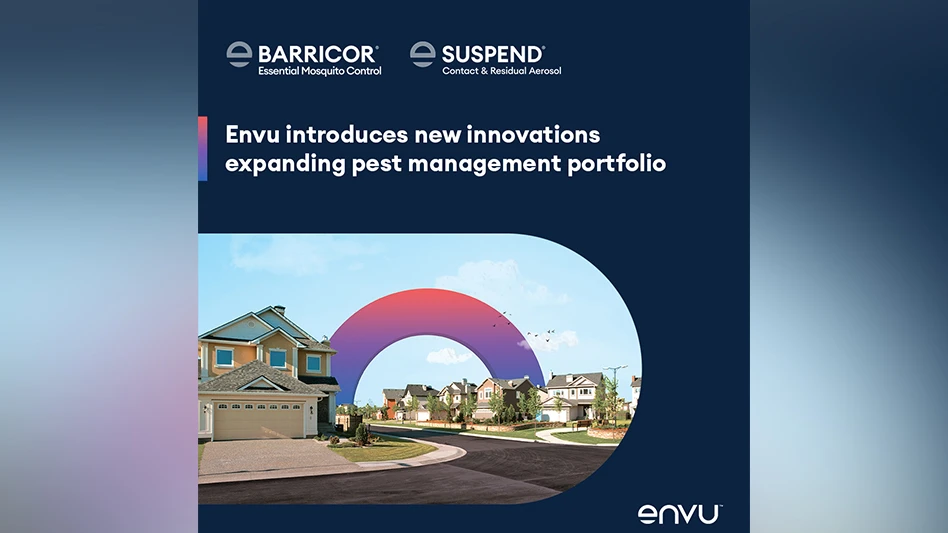 In the early- to mid-2000s, performing termite pretreatments in some parts of the country appeared akin to printing money. "During the heady days of the housing boom, where you were seeing 400 to 500 homes going up in developments in Arizona, Nevada or Southern California, there were firms that focused their entire businesses on pretreatments," says Gary Curl, president, Specialty Products Consultants, Mendham, N.J.
In the early- to mid-2000s, performing termite pretreatments in some parts of the country appeared akin to printing money. "During the heady days of the housing boom, where you were seeing 400 to 500 homes going up in developments in Arizona, Nevada or Southern California, there were firms that focused their entire businesses on pretreatments," says Gary Curl, president, Specialty Products Consultants, Mendham, N.J.
Today, many of those companies no longer exist, along with the builders and real estate agents who hired them.
In Nevada, for example, the ramifications were so drastic, the state's Agriculture Department notified PCOs that its termite pretreatment database was "incomplete," and forced PCOs to begin submitting Termite Pretreatment Notification forms on all preconstruction treatments so that it could reconstitute its handle on pretreats. In the August 2010 directive, Nevada pest control licensing official Lee Lawrence wrote, "As we all know, the new residential and commercial construction industries have changed drastically since 2007. Builders, developers, subcontractors (including pest control companies), owners, financial institutions, businesses of all types...have all been affected by the severe economic downturn. Many businesses associated with residential construction have gone out of business."
The scenario is a sobering reminder that when things appear to be too good to be true, they usually are. For today we find ourselves in an infamous era when even the most iconic symbol of the American dream — the single-family home — is showing cracks in its foundation.
 What Happened? Since World War II, home ownership has served as the average American's best chance at the dream of financial independence. While entrepreneurs risk it all for business fame and Wall Street raiders surfed the perennial waves of the stock market, average Americans could count on the slow, but steady, appreciation of their home — about 1 percent above inflation each year. But with the turn of a new century, the once bedrock real estate market began to look more like a late-night infomercial scheme to get rich quick.
What Happened? Since World War II, home ownership has served as the average American's best chance at the dream of financial independence. While entrepreneurs risk it all for business fame and Wall Street raiders surfed the perennial waves of the stock market, average Americans could count on the slow, but steady, appreciation of their home — about 1 percent above inflation each year. But with the turn of a new century, the once bedrock real estate market began to look more like a late-night infomercial scheme to get rich quick.
According to figures from the National Association of Realtors, from January 1999 to July 2006, the median price of homes sold in the U.S. went from $133,600 to $230,000, a growth of 72 percent, effectively increasing the average homeowner's net worth by nearly $100,000 in just six years.
Of course, as is now painfully obvious, the gains were based on loans that shouldn't have been made, inflated prices and financial decisions that bordered on outright fantasy. "During the great run up of prices, people paid an awful lot for housing and it just wasn't sustainable. That, coupled with the fact that a lot of people took out second loans — second mortgages or home equity loans — and they blew the money on high-end cars and vacations. Essentially people leveraged their homes to pay their credit cards," says Jed Smith, managing director, Quantitative Research, National Association of Realtors. "The net result is we sit here with a group of potential buyers who are underwater and struggling to hold on to their current house. We were on a binge for several years and now it has caught up to us."
Today, distressed property — homes being sold due to loan defaults — represent 35 to 40 percent of home sales. What's a normal percentage? "I don't think anybody ever bothered to keep track of it because it was essentially zero, but let's call it 2 or 3 percent," Smith says.
The unprecedented number of foreclosed homes has pulled down all home prices an average of 25 to 30 percent. Further, housing starts — a measure of new construction — declined from 2 million in April 2005 to just more than 500,000 as of April 2011.
All of this, of course, has impacted pest management professionals, particularly those involved in preconstruction termite treatments and wood-destroying organism inspections associated with real estate transactions.
According to Curl, who each year gathers pest management market data, the industry has lost $600 million of total annual termite revenue from a peak in 2005. In 2005, Curl's research survey recorded $1.76 billion of termite revenue. In 2009, sales were $1.16 billion.
And the ramifications have extended beyond just termites. "When you have higher food and fuel costs it is going to impact homeowner's discretionary spending. Someone who in better economic times may have called a PCO, may elect to try to get control of the situation by a DIY method," Curl says. In fact, this past year's (2010) research indicates that, on average, each pest management firm has reduced its GIC staff by one technician.
When Will It Get Better? The conventional economic wisdom is that ups and downs are a part of any market. Just as the stock market recovered from the tech bubble of the 1990s, surely the laws of the business cycle mean housing will spring back to life any minute now, right?
Unfortunately, no.
In fact, many housing economists aren't even convinced that we've hit bottom. "In general, current trends are consistent with our earlier expectations of depreciation rates improving...but from absolute levels that are high enough and at a pace that is slow enough that a bottom won't be reached this year," wrote Dr. Stan Humphries, in a June 6 market update. Humphries is chief economist with Zillow Real Estate Market Research.
 This April 25, 2011, cartoon by the Pittsburgh Tribune-Review’s Randy Bish illustrates the slow housing market recovery. A tough economy, high unemployment and tougher lending standards all mean few people can take advantage of discount-priced homes. This April 25, 2011, cartoon by the Pittsburgh Tribune-Review’s Randy Bish illustrates the slow housing market recovery. A tough economy, high unemployment and tougher lending standards all mean few people can take advantage of discount-priced homes. |
The key issue, Smith says, is the combined effect of a tough general economy and high unemployment. "During the deflation after the boom, the country lost about $14 trillion worth of assets due to declines in the stock market and the housing market. Losing $14 trillion of assets is about like losing a year's pay, because the economy produces about $14 trillion worth of goods each year."
That fact, coupled with 9 percent unemployment and tougher lending standards, means very few people can take advantage of the huge inventory of discount-priced homes — a condition that might ordinarily help fuel a recovery.
"If you don't have a job or fear you may lose your existing job, you are not very anxious to buy a house, nor can you buy a house. I think people will be a lot more cautious, and I don't see the economy producing a lot of additional jobs right now," says Smith, who foresees housing stagnation for as long as four years.
The National Association of Realtors forecasts that 2012 will see a 4.3 percent increase in the number of houses sold, at a price appreciation of just 2.5 percent.
The new construction market looks slightly rosier, with the National Association of Home Builders forecasting a 2 percent increase in housing starts in 2011 and a 34 percent increase in 2012.
 Dear Bed Bugs: Thank You. Remarkably, despite the housing doom and gloom, many PCOs have weathered the storm well. Overall revenue in the industry has remained relatively flat, quite an accomplishment considering the historically bad economy.
Dear Bed Bugs: Thank You. Remarkably, despite the housing doom and gloom, many PCOs have weathered the storm well. Overall revenue in the industry has remained relatively flat, quite an accomplishment considering the historically bad economy.
"As a whole, our industry has remained strong and steady," says Missy Henriksen, vice president of Public Affairs, National Pest Management Association. "Sales revenue, overall, has been fairly consistent, so I don't know that our industry has been dramatically affected other than in termite pretreatment."
Part of the stability can be credited to America's latest pest sensation, bed bugs. Curl's research indicates that sales from bed bug control climbed nearly 25 percent from 2009 to 2010, accounting for about $320 million of total revenue.
New Opportunities. As always, housing bust or not, savvy PCOs figure out ways to deepen their relationships with existing customers and maximize new opportunities when they appear. For example, Dr. Chris Christensen, Christensen's Urban Insect Solutions, Lexington, Ky., says his firm's wildlife control business is holding strong. Christensen, who owns a Critter Control franchise, has boosted revenues by offering wildlife-related add-on services like chimney caps and other property improvements.
PCOs will need that kind of entrepreneurial spirit to continue to flourish in the coming years. "I see (the housing market downturn) as a long-term problem," Curl says. "If your business is completely focused on pretreatments, you either have to change or you are going to die. You can't continue to focus your business on a single segment that is declining."
The author is a former editor at PCT magazine. He can be reached at ssmith@giemedia.com.

Explore the September 2011 Issue
Check out more from this issue and find your next story to read.
Latest from Pest Control Technology
- How to Get Rid of Odorous House Ants
- Massey Services Promotes Herndon to Director of Sales for Multi-Family Division
- NPMA Announces First Recipients of NPMA PRO Certified Credential
- Pestmaster of the Hudson Valley Acquires Catskill Animal Damage Control
- Photo Slideshow: Ant Identification Tips
- Video: Top 10 PCT Photo Contest Finalists
- UF/IFAS Study Reveals Boats as Perfect Vessels for Global Termite Spread
- Pest Control Consultants (Iowa) Earns Pinnacle Performance Award








